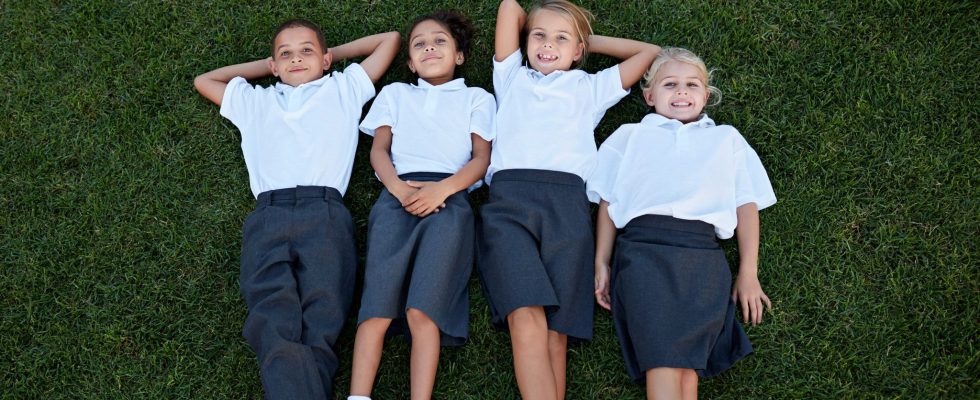A blouse. Maybe pants and a shirt. Or jeans and a t-shirt, for the more modern ones. With or without distinction between girls and boys. To resolve attacks on secularism in schools, should we impose the wearing of uniforms, the eternal political and media refrain of the start of the school year, as requested by certain teachers and political representatives? After banning the abaya, this long traditional dress that some young girls wear as a religious outfit, the Minister of National Education, Gabriel Attal, recently said he was in favor of “experimenting” with the uniform, already implemented in schools, colleges and high schools in Guadeloupe, Guyana and New Caledonia.
The minister’s idea: carry out tests in a few establishments to measure the usefulness of imposing a single outfit in classrooms. And thus try to shed light on the recurring discussions on this subject, which divide even within the majority. Barely stated, the proposal attracted enthusiasts: the presidents of the departments of Alpes-Maritimes and Bouches-du-Rhône volunteered, convinced of the potential benefits in their colleges, while, throughout the territory, 298 students, out of the 12 million returning to school, were reprimanded because they wore the abaya. The terms of the experiment should be announced “in the fall”, indicated Gabriel Attal.
These tests will likely give some indication of the level of acceptance of the measure, and help determine whether it is easy to adopt. In particular, it will be necessary to designate who will finance the purchase of the recommended clothing. But these experiments risk proving inconclusive in measuring any contribution beyond a simplification and clarification of dress rules at school. If the school uniform is sometimes made a flagship tool for resolving certain issues, from secularism to integration, including the classroom atmosphere and student success, until now no study has made it possible to decide . “In reality, the research is not sufficiently conclusive on the question. Thus, nothing suggests that there is an effect on learning or on behavior”, underlines our columnist Franck Ramus, research director at the CNRS , specialist in cognitive development.
The United States is doing it, without result
In 2021, the British think tank Education Endowment Foundation (EEF), a reference source in educational sciences, has attempted to condense the work carried out on the subject. Only seven scientific articles then presented a methodology rigorous enough to be likely to provide lessons. An insufficient number to conclude, especially since school uniforms are complex objects of study: “Uniforms often come accompanied by other measures, which makes the evaluation of their potential effects particularly difficult”, details the organization in a review.
In 2022, however, a new study looked specifically at the issue in the United States. Because there, the uniform is coming back into favor. In public schools, 20% of children wear it, compared to only around 3% in 1995. And 6 out of 10 private schools have made it compulsory. But, again, no visible effect. “Students in uniform did not demonstrate better social skills, less withdrawal, or better school attendance than others,” concludes the article published in the journal Early Childhood Research Quarterly, which covered 6,320 students from kindergarten to the end of primary school.
In Europe, only two countries, Malta and Cyprus, impose uniforms in their schools, with very diverse objectives. Contrary to popular belief, it is not compulsory in the United Kingdom, often cited as an example, even if, in fact, 90% of establishments require it. And in British schools, it is possible to come to class wearing a veil, a cross or a yarmulke. The model of our neighbors across the Channel therefore does not say much about the usefulness of the measure if we apply it to safeguard secularism – a notion of which France also has a very specific conception, which complicates the international comparisons.
A tradition in Asia and Africa
Despite the lack of information on this subject, wearing a uniform is however common in other parts of the world, in Asia (Japan, South and North Korea, China, etc.), in the former British colonies ( Hong Kong, India, etc.), in Africa and Latin America. But the proportion of students who wear it still varies greatly from one country to another and the rules differ: total imposition (as in Russia), partial (regional, only in public or private), or simple tradition still well anchored. But, again, it is difficult to extrapolate its usefulness in the French context.
If an effect exists, it is not visible through the scientific lens: “Some countries believe that school uniform supports the development of an overall school philosophy and that it helps with discipline and motivation. Some also believe that a uniform promotes social equity. However, there is little strong evidence that the introduction of a school uniform can as such improve student achievement, behavior or attendance,” notes the EEF . “Not sure that this is a miracle solution,” admitted Gabriel Attal himself.
To inform the choices available to National Education, the ministry has a scientific council, of which Franck Ramus is a member. According to the researcher, the body was not contacted on this question. Nor on the broader theme of tools likely to improve living together or student behavior. However, scientific consensus exists. After reviewing 89 educational psychology articles, theEEF has published a series of recommendations for teachers. For example, “reinforce positive behaviors” rather than focusing on sanctions, or “teach the techniques to learn”, and not just what there is to learn.
The think tank defends in particular better training of teachers in educational psychology and classroom management, and the development of means of applying the various techniques recognized as operational. A solution which has not emerged in the French public debate until now, to the great regret of Franck Ramus, who trains teachers in these techniques, in partnership with the Ecole Normale Supérieure-PSL and the Canopé network. “The first question before launching something should always be: is there research, does it work?” believes the researcher.
